Review: The Standing Water (Steel String Books) by David Castleton
Some books may be pleasant, easy reads – novels that cosily confirm us in our worldview, our habits and opinions. Other books seize us by the lapels, shake us, drag us to an imaginary window and force us to see the world in a different way and question many of our assumptions.
The Standing Water – the first novel of north-east author David Castleton – undoubtedly falls into the second category.
Emberfield – a town stranded in “godforsaken marshes, soul-destroying flatlands” – is the backdrop for this remarkable modern gothic tale, a tale that delves into the darker side of the rural north of England.


Set in the early 1980s, most of The Standing Water is narrated by Ryan Watson, an eight-year-old schoolboy who’s beginning to suspect his headmaster Mr Weirton is implicated in the deaths of two pupils.
For much of the book, we’re unsure whether to believe him. Emberfield – seen from Ryan’s highly imaginative perspective – is a very odd place. The lines separating the legendary from the mundane, the real from the invented, and even the realms of the living and the dead seem to shift as easily as the mists that float across Emberfield’s plains.
Ryan casually peoples his environment with ghostly drummer boys, phantom kings, curses left by ancient knights, and angels who float down from heaven to herald Christmas – all of which slot as easily into his world as the toys he plays with and the sweets he buys from Emberfield’s grumpy shopkeeper:
“The sun was raising mist from the dew-wet ground. As that mist drifted and hovered, I was reminded of how the knight’s curse still floated over, infused the air around Emberfield, how it spread – even after so many years – its feeling of melancholy and evil, eeriness and foreboding over our land, our town.”
But Ryan does have grounds for his suspicions of his teacher. There’s Marcus – a pupil who may or may not have drowned in a pond outside the school gates. Then there’s Lucy, a ‘skeleton’ Weirton uses to give ‘anatomy lessons’, who the headmaster insists was a badly behaved girl who once attended the school.
There are also Weirton’s ‘traditionalist’ ideas about how to keep his pupils in order. The rages, the ‘thrashings’, the psychological torments the headmaster inflicts on Ryan and his classmates do little to dispel Ryan’s worries about the fates that might have befallen Lucy and Marcus.
As the book progresses, Weirton’s mental state deteriorates and his punishments become more brutal. But – because Weirton and his enthusiasm for discipline are respected by Emberfield’s conservative adults – Ryan can find little sympathy in his hometown. Ryan and his friend Jonathon are therefore forced to come up with novel ways to resist the headmaster.
As some chapters are narrated by Weirton, we also get to see things from his point of view. We see a man scarred by a violent upbringing and unhappy marriage, a man who feels trapped by his job and his life in Emberfield:
“As my pen etched ticks and crosses, I thought about how many hours of my life I must have spent in there … boxed by ceiling, walls, long window. Grey carpet, kids’ garbage on the walls we have to stick up to please the inspectors … in this town as dull as the water in the ditches that gird it.”
Like Ryan, Weirton senses there’s something uncanny and oppressive in Emberfield’s atmosphere, complaining of “something about the place, something ancient and evil that warps my thinking.” He feels he’s being “poisoned by Emberfield’s foul lowland vapours, bewitched by curses that still linger, whisper in the air.”
I found The Standing Water to be a meaty, enthralling novel. Written in beautiful, poetic language, it’s unashamedly literary, but I didn’t find it difficult to read. It certainly kept me turning the pages.
Imagine a strange postmodern lovechild of Edgar Allan Poe, Charles Dickens and Mark Twain, sprinkle that baby with the magical realism of a writer like Gabriel Garcia Marquez, and you’re maybe getting close to describing The Standing Water.
While the novel has a serious message – about the consequences of narrow-mindedness and violence – it isn’t po-faced. The book’s filled with a sly, lively humour that had me chuckling out loud a few times.
So, what are the The Standing Water’s drawbacks? It’s long, it’s literary and – as I said at the start of this review – it’s not the most straightforward novel. It may be a little tough for some attention spans truncated by our social-media age. The book’s violence – and just how dark it can get – might be shocking for some readers.
But, personally, I loved it and if you’re looking for a read that’s challenging and original, I’d recommend picking up a copy. I’d certainly give it five stars!
You can purchase – or learn more about – The Standing Water on Amazon here.
David Castleton blogs at The Serpent’s Pen, where he explores the gothic, folklore, myth, psychogeography, and ‘the dark, the strange and the literary’.
(Featured image courtesy of Neta Bartal, from Flickr Creative Commons.)
















